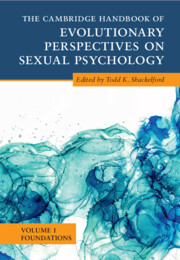Book contents
- The Cambridge Handbook of Evolutionary Perspectives on Sexual Psychology
- The Cambridge Handbook of Evolutionary Perspectives on Sexual Psychology
- Copyright page
- Contents
- Contributors
- Preface
- Part I Foundations of Evolution
- Part II Middle-Level Theories
- 7 Parental Investment Theory
- 8 Parent–Offspring Conflict
- 9 Theory and Evidence for Reciprocal Altruism
- 10 Life History Theory and Mating Strategies
- 11 Sperm Competition Theory
- 12 Sexual Conflict Theory
- 13 Cross-Species Comparisons
- 14 Cross-Cultural Methods in Sexual Psychology
- 15 Behavioral Genetics
- 16 Sex Differences and Sex Similarities
- 17 Individual Differences in Sexual Psychology
- 18 Experimental Methods in Sexual Psychology
- Index
- References
16 - Sex Differences and Sex Similarities
from Part II - Middle-Level Theories
Published online by Cambridge University Press: 30 June 2022
- The Cambridge Handbook of Evolutionary Perspectives on Sexual Psychology
- The Cambridge Handbook of Evolutionary Perspectives on Sexual Psychology
- Copyright page
- Contents
- Contributors
- Preface
- Part I Foundations of Evolution
- Part II Middle-Level Theories
- 7 Parental Investment Theory
- 8 Parent–Offspring Conflict
- 9 Theory and Evidence for Reciprocal Altruism
- 10 Life History Theory and Mating Strategies
- 11 Sperm Competition Theory
- 12 Sexual Conflict Theory
- 13 Cross-Species Comparisons
- 14 Cross-Cultural Methods in Sexual Psychology
- 15 Behavioral Genetics
- 16 Sex Differences and Sex Similarities
- 17 Individual Differences in Sexual Psychology
- 18 Experimental Methods in Sexual Psychology
- Index
- References
Summary
The sciences have been perennially interested in understanding similarities and differences between the sexes. Among humans, both males and females seek to secure serially monogamous partnerships with kind and intelligent mates similar to themselves. However, the sexes differ in the relative value placed on resources and physical attractiveness, their willingness to engage in short-term liaisons, and jealousy in response to emotional and sexual infidelities. Consideration of cultural factors, modern relationship innovations, and diversity in sexual orientation and gender identity provides further complexity to our understanding of similarities and differences. Recommendations are made for future research in these areas, and the societal implications of evolutionary work on the sexes is discussed.
- Type
- Chapter
- Information
- Publisher: Cambridge University PressPrint publication year: 2022

